While pottering around our inner-city garden, there's always some kind of background noise, whether it's merely traffic, neighbours talking, or local birds calling to one another. But the sound I enjoy the most is the hum of bees.
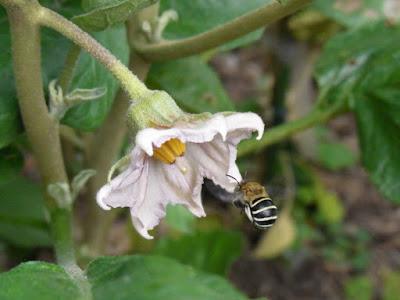
A native blue-banded bee closes in on an eggplant flower.
Not only is it a happy sound but it's also a vital signal that our backyard garden is a safe place for bees and other insects to go about their work, and make a living. Doing the right thing by bees isn't rocket science. There's just two steps.1. Plant bee-friendly flowering plants (and there are lots of them)
2. Stop using harmful insect sprays that kill bees and other beneficial insects.

Bees go mad when our lemon tree flowers, which it will do soon.
As spring is upon us here in Australia, and gardeners everywhere are thinking "what can I plant now", it's the perfect time to put in a plug for becoming a bit more bee-friendly, whether you're a balcony gardener, own a rambling country estate or, like Pam and me, have an ordinary suburban backyard.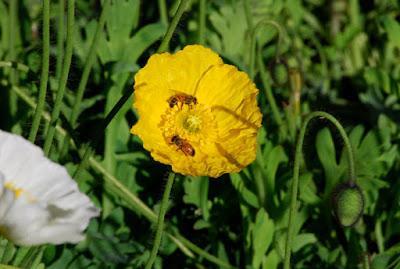
Our poppies are blooming now, and bees almost bathe in the plentiful pollen.
Now, I've done numerous postings about bees over the years, and this latest one has been prompted by an email I received from Taronga Zoo (for out-of-towners, Taronga Zoo is Sydney's largest and oldest zoo, situated on the edge of Sydney Harbour — visiting Taronga is a part of most Sydney childhoods. It was certainly part of mine, with countless visits there).It might come as a surprise to some to know this, but Taronga Zoo cares for its bees in the same way it does for all its other creatures — with loving devotion. This Sydney winter has been very dry indeed — there's a drought on — and so flowers are fewer and life is tougher for Taronga's bee population (and all other bees in Sydney). One simple reason for looking after bees is that Taronga has its own vegie patch, to provide food for its animals, and as every vegie gardener knows, bees play a vital role in pollinating all sorts of crops.
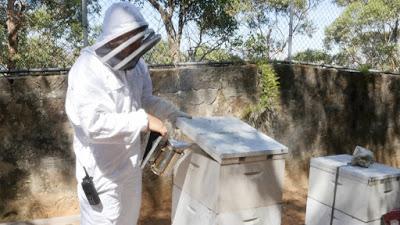
Taronga's beekeeper inspects one of their hives.
What Taronga would like everyone in Sydney to do is simple: make your garden friendlier for bees. So here's some very basic tips on how to get started, but before I do that, I have to include this next photo, just to show you how popular beekeeping has become in Sydney.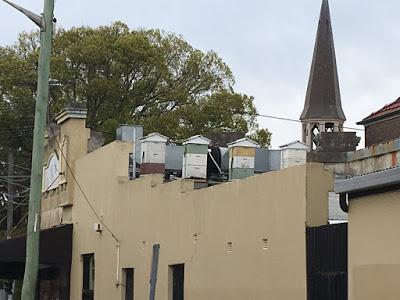
About 200m from my house, the roof of this corner shop in Marrickville is
very probably what my busy backyard bees called "Headquarters". And so
in doing my bit in the inner-city, I'm helping gourmets to be happy.
Flowering shrubs: lavender probably tops the list, but all daisies are fabulous, too. Shrubs such as abelia and buddleia are famous bee-attractors, but on a small scale little alyssum (sweet Alice) and nasturtiums do a great job, and so do my poppies. But all annual flowers are great for bees, and probably the perfect choice for smaller gardens and balconies.
Natives: all the flowering native shrubs are brilliant bee magnets, but top choices would include hardenbergia, grevilleas (which come in all shapes and sizes), bottlebrush, westringia (coast rosemary, a very good hedging plant), and native daisies (Brachyscome).
Herbs: most people think "foliage/leaves" when you say "herbs", but all herbs flower well and bees love them. Basil is terrific (and now is the time to plant some), but oregano, marjoram, sage, rosemary, mint, coriander and lemon balm all do a great job attracting bees. Borage is probably the star of the bee-friendly herb garden, as bees adore its plentiful blue flowers.
Flowering vegetable crops also attract (and need!) bees, especially tomatoes, eggplants, potatoes, zucchini, cucumber, pumpkins, watermelons and squash. So my tip is to plant some low-growing flowers next to your vegie patch, such as alyssum, petunias, low-growing daisies, etc. It's what "potager" gardens are all about: mixing flowers, herbs and vegies together so they attract bees. And besides, potagers just look better.
My citrus trees (lemon, Tahitian lime, Thai lime) all attract stacks of bees, and spring is a great time to plant one, and it's also the perfect time to fertilise them. All other fruit trees are magnets for bees when they are in flower, so if your garden design needs a small tree, think about a fruit tree next time round.
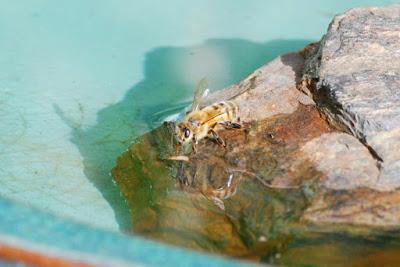
While the name of this thing is a "birdbath" nobody told the bees they can't
visit, so I always make sure there is a gently sloping rock in my birdbath so
bees and other flying little guys can take a drink, especially on a hot day.
Finally, you can also test out my favorite bee theory: no matter where you put a flowering plant, bees will find it. Go on, plant something in an out-of-the-way spot and keep an eye on it. Once it starts flowering, our little busy, buzzing hard-workers will soon be all over it. That's what I love about bees ... they are so good at their jobs!
